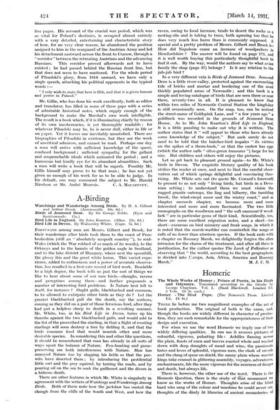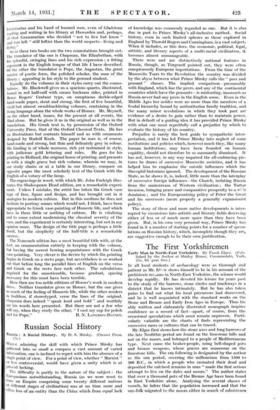Homeric
The Whole Works of Homer ; Prince of Poetts, in his Iliads and Odysseys. Translated according -to the Greeke by George Chapman. Vol. I. (Basil Blackwell. Limited Ed. 5' Vols. £3 3s. each.) THERE lie before me two magnificent examples of the art of book production. The original of both is the same, and,
though the books are widely different in character of produc- tion, they are each remarkable for the appropriateness of their design and execution.
For when we use the word Homeric we imply one of two widely differing qualities. In one use it arouses pictures of
colourful, vigorous, pulsating life : Achilles flaming across the plain, feasts of oxen and beeves roasted whole and washed down with deep -draughts of mead and wine,: the passionate hates and loves of splendid, vigorous men, the clash of swords and the clang of spear on shield, the sunny -plain where warrior kings take counsel in glittering assembly, voyages, adventures,
enchantments, life the more vigorous for the nearness of danger and death, but always life.
There is, however, the other -use of the word. There is the Homeric Question, there is the study- of Mat monument we know as the-works of Homer. Thoughts arise -of the blind bard who sang of the colour and tunshine -he could never see, thoughts of the dimly lit libraries of ancient monasteries, Of reisistratus and his band of learned men, even of Gladstone reading and writing in his library at Hawarden and, perhaps, of that Grammarian who decided " not to live but know " and was left " still loftier than the world suspects—living and
dying." So in these two books are the two connotations brought out The translator of the one is Chapman, the Elizabethan, with his splendid, swinging lines and his rich expression ; a fitting exponent in the English tongue of that life I have described. Of the other the translator is Pope, the Augustan, the great master of poetic form, the polished scholar, the man of the library appealing in his style to the gowned student.
Equally do the volumes in their styles carry out the conno- tations. Mr. Blackwell gives us a spacious quarto, illustrated, bound in red half-calf with cream buckram sides, printed in. Bruce Rogers' Centaur type, on sumptuous deckle-edged hand-made paper, stout and strong, the first of five beautiful, vivid but almost swashbucklering volumes, containing in the living language alone the whole works of Homer. Mr. Meynell, on the other hand, issues, for the present at all events, the Iliad alone. But he gives it us in the original as well as in the translation. His Greek text is, by permission of the Oxford University Press, that of the Oxford Classical Texts. He has no illustrations but contents himself and us with ornaments designed by Rudolf Koch.. The paper he uses is, of course, hand-made and strong, but thin and delicately grey in colour. His binding is of whole morocco, rich yet restrained in style, with judicious gold lettering and rules. He goes for his printing to Holland, the original home of printing, and presents us with a single grave but rich volume, wherein we may, in our study chairs or at a table in our library, compare on opposite pages the most scholarly text of the Greek with the English of a votary of the lamp.
The engravings in wood, with which Mr. John Farleigh illus- trates the Shakespeare Head edition, are a remarkable experi- ment. Unless I mistake, the artist has taken the Greek vase type of face, figure and design, and has brought out in it analogies to modern cubism. But in this medium he does not hesitate to portray scenes which would not, I think, have been appropriate to Greek vase-painting of Homeric life, and which have in them little or nothing of cubism. He is vitalising and to some extent modernising the classical severity of the vase, and the experiment is certainly interesting, but not in my opinion more. The design of the title page is perhaps a little florid, but the simplicity of the half-title is a remarkable success.
The Nonesuch edition has a most beautiful title with, at the foot, an ornamentation entirely in keeping with the volume, but having the merest bowing acquaintance with the Greek vase-painting. Very clever is the device by which the printing begins in Greek on a recto page, but nevertheless is so worked out that before long the parallel lines of English on the verso and Greek on the recto face each other. The calculations required for the unnoticeable, because gradual, spacing necessary for this must have been terrible.
Here then are toe noble editions of Homer's work in modern dress. Neither translator gives us Homer, but the one gives us much of the feeling of Homeric life, while the other renders in faultless, if stereotyped, verse the lines of the original. Chapman does indeed " speak loud and bold " and worthily are his words here presented. But there are not a few who will say, when they study the other, " I cast my cap for polish
























































 Previous page
Previous page